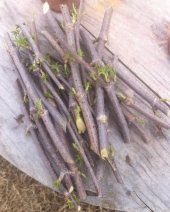
 1
1




“There are no words to express the abyss between isolation and having one ally. It may be conceded to the mathematician that four is twice two. But two is not twice one; two is two thousand times one.”
― G. K. Chesterton
 7
7




 1
1








“There are no words to express the abyss between isolation and having one ally. It may be conceded to the mathematician that four is twice two. But two is not twice one; two is two thousand times one.”
― G. K. Chesterton
 8
8




'What we do now echoes in eternity.' Marcus Aurelius
How Permies Works Dr. Redhawk's Epic Soil Series
 2
2




Malek Ascha wrote:
On a more meta level, I'm curious how one develops the skill of identifying plants. Is it just about experience? Is there any literature/references y'all would recommend?
Building regenerative Christian villages @ https://jesusvillage.org/
100+ Homesteading Software Tools @ https://homestead.tools/
 1
1




“There are no words to express the abyss between isolation and having one ally. It may be conceded to the mathematician that four is twice two. But two is not twice one; two is two thousand times one.”
― G. K. Chesterton
 3
3






 1
1




Skandi Rogers wrote:also the leaves smell VILE when you crush them.
Building regenerative Christian villages @ https://jesusvillage.org/
100+ Homesteading Software Tools @ https://homestead.tools/

 2
2




I ran outside to my mature red elderberry to try this, I thought they smelled quite nice; almost like cut grass.
How Permies works: https://permies.com/wiki/34193/permies-works-links-threads
My projects on Skye: The tree field, Growing and landracing, perennial polycultures, "Don't dream it - be it! "
 5
5




T Simpson wrote:
Skandi Rogers wrote:also the leaves smell VILE when you crush them.
After I read this I ran outside to my mature red elderberry to try this, I thought they smelled quite nice; almost like cut grass. Is it just the young plants that smell?
I am only one, but still I am one. I cannot do everything, but still I can do something; and because I cannot do everything, I will not refuse to do something that I can do. (E.E.Hale)
 4
4





“There are no words to express the abyss between isolation and having one ally. It may be conceded to the mathematician that four is twice two. But two is not twice one; two is two thousand times one.”
― G. K. Chesterton
 1
1




Permaculture...picking the lock back to Eden since 1978.
Pics of my Forest Garden
















How Permies works: https://permies.com/wiki/34193/permies-works-links-threads
My projects on Skye: The tree field, Growing and landracing, perennial polycultures, "Don't dream it - be it! "




Malek Ascha wrote:
One drawback I can think of is that I haven't actually tasted the berries from this plant yet, so they might actually be terrible and not worth growing more of.
Building regenerative Christian villages @ https://jesusvillage.org/
100+ Homesteading Software Tools @ https://homestead.tools/
 3
3




“There are no words to express the abyss between isolation and having one ally. It may be conceded to the mathematician that four is twice two. But two is not twice one; two is two thousand times one.”
― G. K. Chesterton
 1
1




“There are no words to express the abyss between isolation and having one ally. It may be conceded to the mathematician that four is twice two. But two is not twice one; two is two thousand times one.”
― G. K. Chesterton
 2
2




 1
1




I am only one, but still I am one. I cannot do everything, but still I can do something; and because I cannot do everything, I will not refuse to do something that I can do. (E.E.Hale)
 1
1




Malek Beitinjan wrote:I found this growing under my deck. Can anyone identify it? I think it might be nettles but I'm uncertain.
 2
2




Andrew Pritchard wrote:
Malek Beitinjan wrote:I found this growing under my deck. Can anyone identify it? I think it might be nettles but I'm uncertain.
Looks like ground elder. Anywhere else in the world it's a weed which is a bloody nightmare to get rid of since it spreads and kills off other plants.
“There are no words to express the abyss between isolation and having one ally. It may be conceded to the mathematician that four is twice two. But two is not twice one; two is two thousand times one.”
― G. K. Chesterton




 2
2




Malek Beitinjan wrote:
Andrew Pritchard wrote:
Malek Beitinjan wrote:I found this growing under my deck. Can anyone identify it? I think it might be nettles but I'm uncertain.
Looks like ground elder. Anywhere else in the world it's a weed which is a bloody nightmare to get rid of since it spreads and kills off other plants.
From what I've read about ground elder I don't think this is it. Ground elder is described as a creeping groundcover that spreads via rhizomes, whereas this plant is growing like a shrub. It produced a single set of flowers which also don't resemble the ground elder ones - forgot to take a photo though.

|
I'm still in control here. LOOK at this tiny ad!
The new kickstarter is now live!
https://www.kickstarter.com/projects/paulwheaton/garden-cards
|









